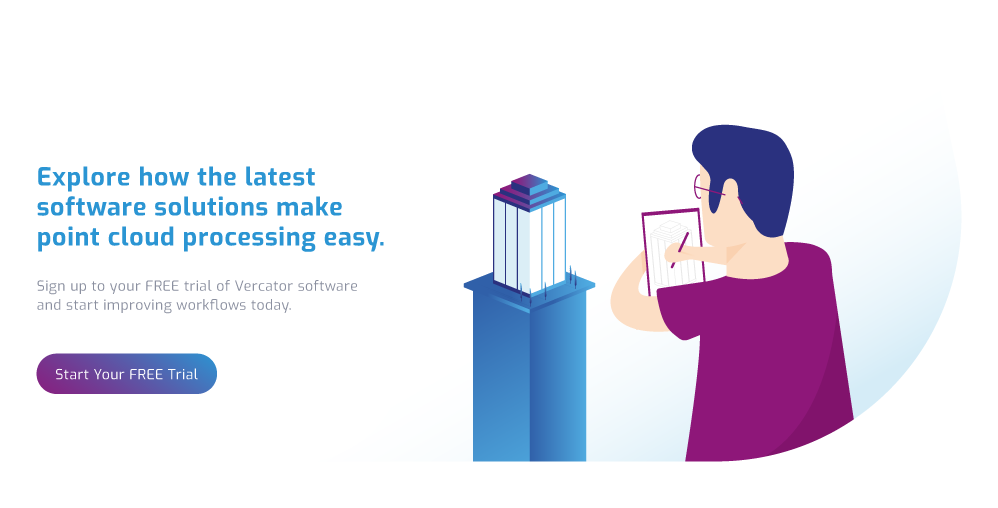6 industries that need to understand point clouds in 2019

Advances in registration and point cloud processing are rapidly expanding the applicable scenarios for the use of reality capture and 3D modelling. Multi-stage vector analysis, developed by cutting-edge software firms, has reduced the time it takes to register a point cloud survey dataset by 40%-80%. Whilst this reduces manual oversight, it can also significantly reduce the cost of commissioning a site survey.
Although only starting to gain traction in many industries, the practice is poised to create a 3D survey renaissance. Businesses are now able to gain a competitive advantage by seizing the numerous opportunities delivered by reality capture and point cloud technology.
Here is our list of the top 6 industries that can benefit from point clouds, reality capture and 3D models in 2019.
#1. Construction
Point clouds are a dynamic storage technology that drives the mapping of spatial data, enabling 3D surveys and modelling of real physical space. For construction projects that rely heavily on planning and accurate outcomes, the ability to create precision 3D models delivers obvious practical applications.
The intricacies of an existing site can be captured in exact detail to produce a 3D model which then forms the basis of planning. Construction schedules can be produced without repeated site visits by all of the specialists involved in the creation of those plans. This delivers particular value for renovation projects, but is a valuable asset for any construction team.
The value of 3D models created from point clouds does not end with planning. Surveys can be deployed at various points of the project, scanning each stage to make sure that the work being carried out conforms with planning. This allows for greater quality assurances and quicker identification of mistakes. These types of assurances make it easier to engage with prefabricated materials and cutting edge manufacturing techniques such as 3D printing - both of which decrease costs and increase efficiency.
Construction is already undergoing a digital shift, with BIM (Building Information Modelling) becoming an industry standard for planning and modelling — making the use of 3D models and schedules more common across larger segments of the construction team. The use of point clouds and BIM simultaneously improve the value of one another, creating better and more useful 3D models that are shared across a wider range of the construction team.
The use of point cloud surveys to create BIM schematics has such potential utility it has been given a name: ‘scan-to-BIM’. Large construction projects have long made use of reality capture and point cloud technology. But, in 2019, construction teams of all sizes need to reassess how they deploy point clouds, and make sure they are getting all of the logistical, planning and quality assurance benefits they can out of this powerful technology toolset. Point cloud tech is an essential investment for any project manager.
#2. Architecture
While the use of point cloud and BIM technology can be utilised throughout every step of the project’s life cycle, design teams stand to benefit enormously.
The improved access to initial site data delivered through reality capturing, point cloud surveys can be fed directly to architects, allowing them to design with the existing site in mind. 3D models can then be shared across the team, allowing architects to gain input from structural engineers and material specialists. This pushes the boundaries of what it is possible to design and then build.
Point clouds deliver further improvements to quality assurances as projects progress. Scanning various stages of a project as it progresses allows those technical limits of design to be pushed as far as possible, and the ability to quality check 3D printed and prefabricated materials allows these manufacturing decisions to be baked into design templates.
Renderings of drawings, plans and sections can provide accuracy to less than a millimetre, enabling for the very best layout proposal and structural integrity testing during those architectural development phases.
#3. City Planning and Civil Engineering
Point clouds provide incredibly intricate insight into complex physical spaces that can be explored and manipulated in a digital medium. This is exactly what city planners and civil engineers need to get their jobs done more effectively and efficiently. Improved registration and processing technology are delivering the efficiency and accessibility needed to take the large number of scans actually required to map a city in the detail that only point clouds can deliver.
This is another area where BIM collaboration techniques further multiply the value of investing in reality capture and point cloud technology. Professionals boasting unique skills related to point clouds and BIM can collaborate together on complex projects and large engineering tasks on a high level and a granular one.
City planning and civil engineering teams are increasingly tasked with creating smart cities that are built around the concepts of efficiency, sustainability, economic development and an enhanced quality of life for workers and residents alike. The complexities of those challenges make the adoption of point clouds particularly useful due to the wider scope of vision, and create efficiencies in manual processes that free up time to focus on these new tasks.
The ability to render drawings and models from scans of existing buildings and terrains opens the door to strategic positioning of buildings, pathways and other crucial elements that help a smart city unlock its true potential. Implementation through digital representations can forecast the immediate appearance and function but, crucially, also helps planners to predict future evolutions.
Integration with 3D city maps allows the vast levels of data to be managed seamlessly while the continued production of geographical datasets allows for ongoing analysis of how people are using the city. Dynamic designs additionally utilise cameras and other modern tech facilities alongside the 3D mapping for heightened levels of detail for intricate planning of renovations and new constructs throughout the city.
The desire to improve city planning through advanced civil engineering can be dated back centuries. In the 21st century, point clouds are the key to getting it right
#4. Computer-Aided Manufacturing
Point cloud technology offers instant access to an array of plans and models that can help test ideas in a virtual environment, create bespoke designs and test manufacturing output against planning. All of these factors are a huge benefit of computer-aided manufacturing.
CAM industries rely heavily on intelligent designs, which is why the accurate scans produced by laser scanning and point clouds can play an integral role in the development.
Scanning finished products or prototypes to create digital designs that can be fed into the CAM processes is just one example. The ability to make CAM designs quickly based on hand-crafted models allows for the rapid creation of bespoke CAM products. If no re-tooling is required, this can even make it profitable to produce affordable limited release products using CAM techniques.
3D modelling unites IT, engineering and product design to streamline the processes and optimise the collaborative communication between various departments. It compartmentalises the manufacturing journey while providing transparency and a level detail that could not be matched without the use of point cloud systems.
Computerised manufacturing requires accuracy as even the smallest margins of error can lead to significant problems with the final designs and production runs. Point clouds enable the creation of accurate 3D models. Their use as a quality assurance mechanism, scanning output as it rolls off the assembly line, delivers a near 100% guarantee that what is produced matches specifications.
CAM has been around for several generations but has evolved over time. The introduction of the latest cloud point technologies is the ultimate way to encourage smoother processes and communication across the team. The production of 3D representations and digitalised renderings streamlines the whole process, allowing teams to work with far greater confidence. Simplified point cloud registration and processing technology makes it simpler to deploy this technology on the go, and affordable to do so many times throughout the CAM process.
#5. Digital Design
Lines between the digital world and real-world environments are more blurred than ever before. Point cloud technology delivers 3D modelling and the ability to compare them to physical spaces with immense ease, flexibility and accuracy with real-time changes that can be viewed by an entire team. Therefore, building upon the ideas embraced by architects and CAM specialists, the use of the technology can be transferred into a world of different digital design environments.
Point cloud surveys can be used to interact with the real world when handling digital designs for products set in a virtual environment. Game designers can replicate real-world scenarios in the virtual arena, whether it be a sports stadium or a city, to provide an authentic gaming experience. Meanwhile, VR development teams are able to use drawing and 3D modelling for interactive digital representations that ultimately lead to greater accuracy in the final digital product. This can be used for clients ahead of a project as well as consumers in the field of entertainment.
From extrapolation on CAM to clothing design and simple manufacturing ideas, design teams are increasingly eager to discover how point cloud and reality capture technologies — especially the advanced options that provide faster results through automation — can be absorbed by their current techniques for greater efficiency. This pushes the boundaries of design, not least with regards to expressing proposed innovations during the pre-production phases.
Point cloud tech can be used in many aspects of digital design and, in 2019, should be embraced by all professionals eager to capitalise on the plethora of opportunities presented by the futuristic landscape.
#6. Anyone with a bright idea
Once upon a time, point cloud and reality capture technology was only a worthwhile investment for those working in very specific industries due to costs and practicalities. However, the increased affordability has lowered the financial restrictions of deploying reality capture technology or commissioning a 3D survey. Virtually anyone with a bright idea has the ability to access point cloud technology.
Point clouds can be used to improve a home renovation project, help a freelance set designer build the background for a production or enable a boutique clothing manufacturer to design a new product line. The possibilities only continue to spiral.
Point cloud imaging can be used for ideas ranging from the basic items to complicated designs. This includes printing 3D figurines, plane parts and various other items. Companies are even experimenting with point clouds, 3D printing and digital models to create printed organ tissue for transplant.
We are looking at unprecedented reductions in the cost of point cloud and technology and the rapid expansion of its accessibility. Industries that have typically accessed point cloud technology and 3D surveys need to look at their options again in a new light — expanding the use cases and making sure that they are gaining as much value as possible. But, new industries and entrepreneurs should look at point clouds and reality capture as a potential backbone for new whole new products, services and offerings.
The adoption of targetless point cloud tech has reshaped the world of design as we know it. Experts working in any industry that can utilise models and plans should think about investing in the point cloud technologies. As technology improves in accessibility, the options only continue to grow. Anyone with a bright idea might invent the new best use case for point clouds — everyone should take note.
Tags: point clouds

